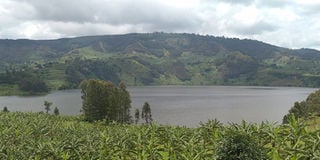Government moves to save Rubirizi crater lakes

Lake Rutoto which is the main source of water in Rubirizi District is among the water bodies threatened by farming activities. PHOTO/ ZADOCK AMANYISA
The government of Uganda through the Ministry of Water and Environment has kicked off the drive to restore and protect wetland systems and crater lakes in Rubirizi District.
Crater lakes in Rubirizi District have for a long time been a source of water for domestic use, commercial production, fishing, tourist attractions, hotel investment, and other human activities like farming, but these activities have ended up exerting more pressure on the resources.
Human activities like farming around the lakes have caused silting leading to gradual reduction in water levels, according to the district senior environment officer, Mr Aggrey Agaba. The district is endowed with 32 crater lakes and 20 craters (depressions without water, rivers, and smaller water streams all served by a rich wetland system.
The government-run initiative, "Building Resilient Communities, Wetland Ecosystems and Associated Catchments in Uganda" that aims at restoring wetlands and increasing the resilience of ecosystems and communities living around the wetlands is being funded by the Green Climate Fund (GCF) and United Nations Development Program (UNDP).
Mr Agaba told this publication that the restoration efforts to save the lakes and the entire wetland system in the district derive the mandate from the National Environment Act 2019 which spells out measures that should be undertaken to protect the lakes like creation of buffer zones of 200 meters for bigger lakes and 100 meters for smaller lakes, regulation of activities done around buffer zones.
He said the initiative that requires that people vacate wetlands comes with alternative livelihood so that degradation activities stop and allow restoration and regeneration of the wetland systems.
“Something good with this project is that all the people who have been encroaching on these resources are offered alternative livelihoods. They are given other sources of income so that they can voluntarily leave the wetlands, lakes, river banks so that the income they have been getting from these areas can be obtained even when they are not going there so these areas can get restored and regenerate,” he said.
“Another model is that people who have been encroaching on the lakes receive accurate weather information so that it helps them minimize losses from their farms. If people get to know that we anticipate a drought, it means they will not go to wetlands for planting, if they know much rain is coming, they will prepare trenches so they cannot be greatly affected. This will at the end of the day reduce on the chances of going into wetlands,” he added
Mr Agaba noted that a number of crater lakes have greatly been encroached on by human activities. They include Lake Rutoto, which supplies water to the communities through National Water and Sewerage Corporation (NWSC), pairs of twin lakes of Katinda and Kyamwiga, Kamweru and Kyema, and others like Bugiragi, which have become centers for investors in hotel business and community activities.
The project which started in Katerera county and is expected to extend to Bunyaruguru county has so far provided livelihood options to about 655 people from sub counties of Katanda, Katerera, Kyabakara, and Katerera town council, where residents have received 492 piglets, 95 goats, 5715 chicks, 380 bee hives, eight fish ponds, dams for irrigation. About 1,000 acres of wetlands have so far been restored in the process.
Livelihoods given to residents include piggery, poultry, apiary, aquaculture, which are purposed to make residents busy outside the wetland systems and boost their income generation.
Katerera town council town clerk, Mr Baker Akampurira stressed that the initiative is timely and will go a long way in fostering conservation of the environment.





